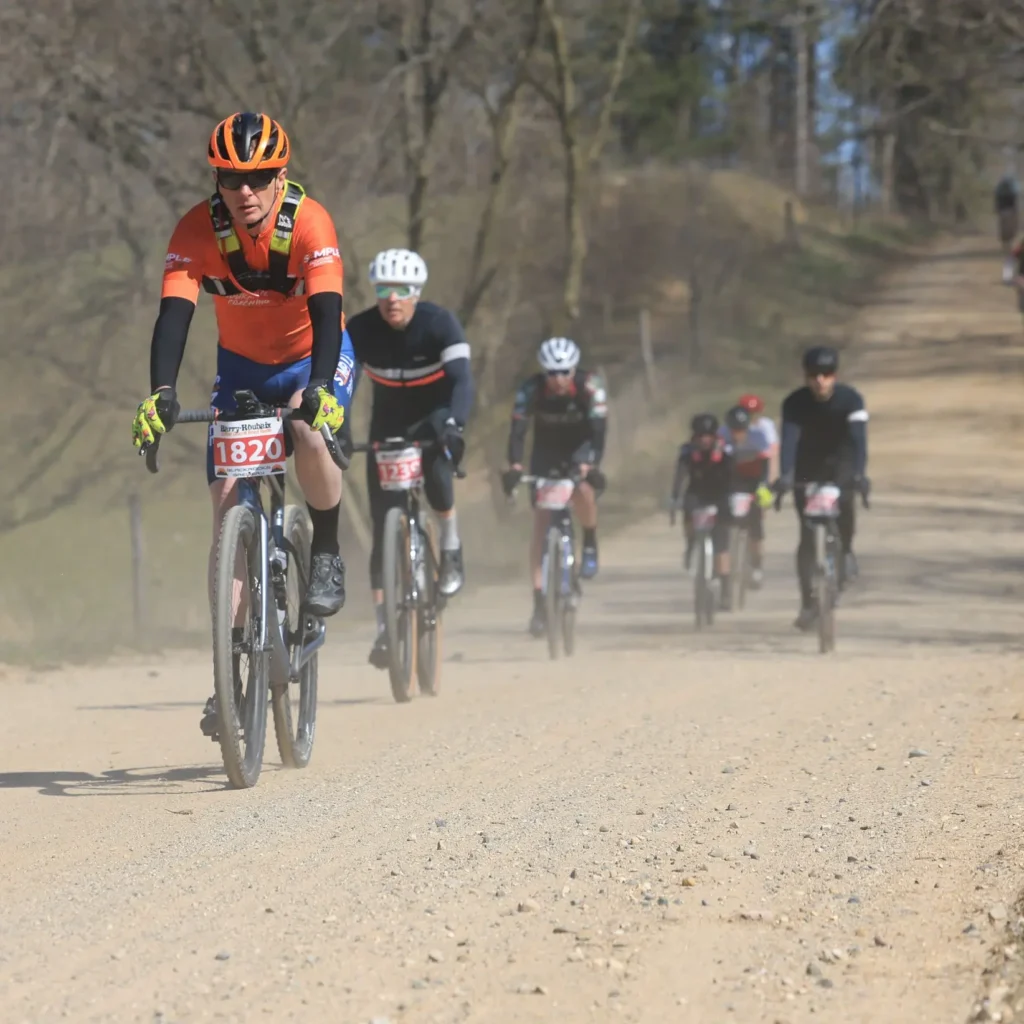by Coach Paul Warloski
You’ve reduced your training volume to freshen up before your A event, whether it’s cyclocross, gravel bike race, or a trail run.
Now match it with smart nutrition during your taper.
During the seven to 14 days before your A-priority race, the goal isn’t to eat less; it’s to arrive topped off: maintain energy, keep protein steady for recovery, and gradually raise carbohydrate intake so the final 24 to 48 hours become a low-fiber carb-load that maximizes glycogen without GI drama.
Practice your race-day fueling in one or two short sessions, salt meals to taste, drink to thirst (not excess), and skip new supplements.
Done right, taper nutrition leaves you feeling lighter on fatigue, heavier on fuel, and fully primed for your best performance.
1) Keep total energy high enough (don’t “diet” the taper)
- As training volume falls 40 to 60 percent during an optimal taper, maintain energy availability so recovery and immune function stay robust.
- Small day-to-day weight gain is common because glycogen stores and body water increase—this is expected and performance-positive.
- Reviews on tapering suggest expanded muscle glycogen is a desirable adaptation.
2) Raise carbohydrate availability as race day nears
- During taper week, aim for approximately five to seven g/kg/day most days to maintain training quality and support glycogen resynthesis.
- In the final 36 to 48 hours, increase to about eight to 12g/kg/day to maximize (supercompensate) glycogen, using familiar, low-fiber carb foods.
- Classic reviews and consensus papers suggest modern carb-loading doesn’t require a depletion phase; a short high-CHO phase with reduced training is effective.
Coach tip: plan actual grams from body mass (e.g., a 70-kg athlete targets about 560 to 840 g CHO/day over the final one to two days). I know, that’s an HUGE amount of carbohydrate. Use liquids/soft foods if appetite is low.
3) Trim fiber and heavy fat only in the final 24 to 48 hours
- To lower GI risk, pivot toward high-glycemic carb staples (white rice, potatoes, low-fiber breads/tortillas, yogurt, low-fiber cereals, sports drinks/gels, rice cakes). Evidence suggests reducing fiber pre-event to lessen GI complaints.
4) Keep protein steady for recovery
- Maintain at least 1.2 to 1.8 g/kg/day protein across the taper to support recovery and satiety (spread over three to five meals).
5) Continue “gut training” in a couple of key taper sessions
- Don’t stop practicing race fueling; the gut adapts. Use one or two short sessions to rehearse your race-day CHO and fluid plan so intestinal transport/comfort stays tuned.
- Reviews suggest nutritional gut-training can improve tolerance and potentially performance.
6) Hydration: arrive hydrated, don’t overdo it
- Across taper week, drink to thirst and monitor urine (pale straw color).
- Before the race, standard guidance is about 500 ml (17 oz) in the two to three hours pre-start, then sip as needed.
- Avoid hyperhydration “chugging.”
7) Consider proven ergogenic aids and time them during taper
Warning: Make sure you practice these in training workouts prior to the race.
You don’t want to try these the day of your A event and find that they don’t work for you!
Nitrates (beetroot):
- Many protocols load around six to eight mmol nitrate/day for two to six days prior, and take a final dose about 90 to 180 minutes pre-start.
- Responses vary by athlete and event; rehearse first.
- You can also experiment with arginine and citrulline, both precursors to nitric oxide.
Caffeine:
- For most, three to six mg/kg 30 to 60 min pre-start (or split doses) improves endurance by about two to three percent on average, but individual responses vary.
- If you’re a heavy daily user and want to heighten race response, a short withdrawal strategy can help some athletes; if you try it, plan enough days that withdrawal symptoms resolve before race day. Always test in training.
Again, don’t start new supplements the day of a race.
Try them several weeks out.
8) Micronutrients, alcohol, and sleep
- Eat a colorful, mixed diet through the week for micronutrients and immune support; avoid experimenting.
- Minimize alcohol (it impairs glycogen resynthesis and sleep).
- Prioritize consistent sleep. It’s your best legal ergogenic.
Seven to 10-day taper fueling outline (plug in body weight)
10 to seven days out:
- Energy: meet needs; slight surplus is fine.
- CHO: Five to seven g/kg/day from mostly normal staples.
- Protein: 1.2–1.8 g/kg/day spread over meals.
- Fats: moderate; keep foods familiar.
- One or two sessions: practice race fueling (e.g., 60 to 90 g CHO/h for long events, using your exact products). You should be practicing race fueling on previous long rides or runs.
Six to three days out:
- Same protein and energy.
- CHO: toward six to eight g/kg/day on harder or longer tune-ups; keep GI-friendly choices.
- If using nitrate, begin loading now.
48 to 24 hours out (carb-load window):
- CHO: eight to 12 g/kg/day, low-fiber emphasis; use some liquids (sports drink, fruit juice cut with water, recovery shakes, rice pudding).
- Salt meals lightly; drink to thirst.
Race-eve dinner:
- Familiar, carb-heavy, low fiber/fat (e.g., white rice + lean protein + simple sauce). Don’t overeat to discomfort; the load is all day, not one meal.
Race-morning (one to four hours pre-start):
- One to four g/kg CHO depending on timing/tolerance; small, familiar options if nerves are high. Final nitrate dose (if using) about 90 to 180 min pre-start; caffeine as rehearsed. Sip fluids to thirst.
FAQ your athletes will ask
“I’m up 1–2 kg and feel heavy—bad sign?”
That’s likely glycogen plus water weight. Fully stocked glycogen can bind about three grams of water per gram of glycogen; those kilos are fuel and coolant, not fat. Performance usually benefits.
“Exactly how much should I drink the day before?”
There’s no magic volume. Start well-hydrated, salt meals to appetite, avoid deliberate over-drinking, and use the about 500 ml two to three hours pre-start guide on race morning.
“Do I need multiple-carb mixes on race day?”
For events over 2.5–3 h, blends (glucose + fructose) support about 90 g CHO/h if trained; practice this during the taper.
Three Things to Know About Race-Week Fueling
- Don’t “diet” the taper—fuel recovery.
Training volume drops, but healing and glycogen restoration are in full swing. Keep calories adequate and protein steady (about 1.2–1.8 g/kg/day). A one to two kg bump from glycogen + water is normal—and performance-positive. - Let carbs climb, then go low-fiber late.
Aim for about five to seven g/kg/day early in the week, then about eight to 12 g/kg/day in the final 24 to 48 hours to top off glycogen. Choose familiar, lower-fiber carbs (rice, potatoes, low-fiber cereals, sports drinks) to reduce GI risk. Race-morning: one to four g/kg CHO depending on timing and gut tolerance. - Hydrate smart and rehearse your plan.
Drink to thirst; add a light salt shake to meals; avoid over-drinking. On race morning, about 500 ml (17 oz) two to three hours pre-start, then sip as needed. In 1–2 short taper sessions, practice your exact race fueling (e.g., 60 to 90 g CHO/h for long events) so your gut is as ready as your legs.
Need more?
Unlock the secrets to mastering gravel racing with our FREE Guide to Gravel Racing! Get yours here.
BOOK A CALL so we can discuss your goals, answer questions, and talk about making your endurance training more effective, fun, and Simple.
Paul Warloski is a:
- USA Cycling Level 1 Advanced Certified Coach
- RRCA Running Coach
- Training Peaks Level 2 Coach
- RYT-200 Yoga Instructor
- Certified Personal Trainer
- Certified Nutrition Advisor




